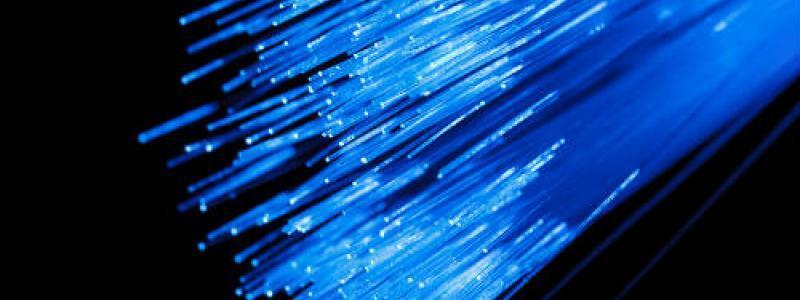Is Dark Fiber the New Trend in Internet?

Dark fiber, another name for the unused optical fibers in internet wiring, is enjoying a renewed burst of popularity. While fiber optics transmit data in the form of light beams, dark fibers are the cables not actually in use.
Dark Fiber Explained
Dark fiber is part of the fiber optic cable that has not yet been used and is not connected to any port. Dark fiber is typically installed to avoid the expense of going inside the wiring to lay more fiber when the client needs better service. The current abundance of dark fiber in the United States stems from the period in the 1990s when the internet, telecom and computer industries began expanding rapidly. Telecommunications companies added massive amounts of unused fibers to their cables, hoping that customers would eventually require more service. Because the market for telecommunications was growing exponentially at the time, this was a logical assumption. However, the advent of wavelength-division multiplexing shattered the dreams of a fiber-filled future. Multiplexing enabled more data to run on fewer fibers. As a direct result, the price of wholesale data traffic collapsed and many companies filed for bankruptcy to protect themselves. However, their loss was everyone's gain: the overabundance of wires has recently been recognized to have value as dark fibers.
Managed dark fiber uses transponders tuned to a set wavelength to beam pilot signals into the fibers. For a dense multiplexed system, central management is typically preferred. Without tightly controlled parameters, the wavelength could be interrupted by wireless signals when amplification needs require transmissions of distances greater than 62 miles.
Virtual dark fiber, using wavelength multiplexing, allows the service provider to permit access to individual wavelengths. Access to narrowband multiplexing channels is given over a wavelength division multiplexed fiber network. Virtual fiber networks are operated at a physical level. Because this type of dark fiber network uses coarse bandwidth division multiplexing, with spacing of up to 20 nanometers, this system is more resistant to wireless interference than managed dark fiber.
Is Dark Fiber Popular?
There are vast networks of dark fibers throughout the United States. More are being laid every day, as TV companies increase their TV connectivity speeds. Dark fiber services, while provided by local exchange carriers, are typically offered to consumers through the phone company.
As businesses and enterprises become more technologically advanced and require higher-speed internet connections, many corporations are turning to dark fiber as a high-speed internet solution. If a manager is considering implementing dark fiber internet technology, there are several important pros and cons that should be considered before taking this step.
Will Dark Fiber Internet Services Work in a Corporation or Home?
Dark fiber must be purchased for the right reasons and with realistic expectations. Dark fiber works best for companies that are growing rapidly and need the ability to manage scalability for point to point connections. Dark fiber connections allow for easy equipment interface change-outs, eliminating the middleman and all the hassle that comes with him. Additionally, the employer will be free from worry about term liability when using a leased circuit--excellent news to all those companies whose bandwidth needs fluctuate unpredictably.
Additionally, dark fiber internet works well for companies with a wide variety of devices accessing their high bandwidth connections. For example, if connections between the company and the data center require a wide variety of interfaces that are not standard, dark fiber internet will enable connection with little difficulty. Dark fiber can dramatically increase internet connection response time.
While it certainly is tempting to consider dark fiber a typical telecom service, it is actually more of a physical asset. As an example, the fibers need maintenance on a regular basis. Service outages for black fiber service tend to last significantly longer than those for standard internet, so this is a problem that should be kept in mind.
In short, dark fiber internet will work for some corporations, but will not be practical for others.
91 Gigabit Internet Transfers
While the staggering 91 gigabit transfer sounds like something directly out of a science fiction novel, NASA's High End Computer Networking team succeeded in transmitting data at such speeds in November of 2013. The data transfer occurred between two centers: a center in Denver, Colorado and the Goddard Space Flight Center in Greenbelt, Maryland. To date, this is the fastest data transfer ever conducted under conditions that are in the realm of possibility. NASA used dark fiber networks for this milestone transfer, proving that some day, it may be possible for the common person to transfer data at almost the speed of light.
If a corporation is interested in increasing the speed of the internet connection, and has widely fluctuating bandwidth needs, the manager should consider purchasing dark fiber internet.
Related Blog Articles
- T-Mobile Now Offers Nexus 9 With LTE
- Kindle App For iOS Gets Updated With Goodreads And More
- T-Mobile Announces Data Stash, A Rollover Program For Unused Data
- Yahoo Weather App Gets Updated With Animated Weather Effects
- Which is Cheaper - Streaming or Buying Cable?
- Check Out These Year-End Deals From Motorola
- What is 4K TV?
- Verizon Now Lets You Send Starbucks Gift Cards Through The Carrier’s Messages App
- Tips For Taking Better Pictures This Holiday Season Using Your iPhone
- Snapchat’s Growth Relatively Unaffected By Hacking Incident Early This Year
Related Blog Posts
- Report: AT&T facilities are used for NSA surveillance program
- Tips for achieving a smartphone detox this summer (or at least for a few days)
- Instagram hits 1 billion users; launches new IGTV video uploading service
- Facebook introduces game shows platform, with live interactive vids
- California Democrats combine two separate net neutrality bills


 Menu
Menu